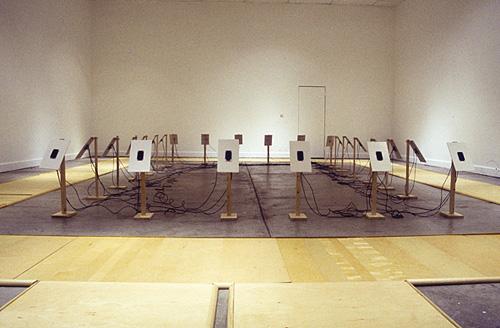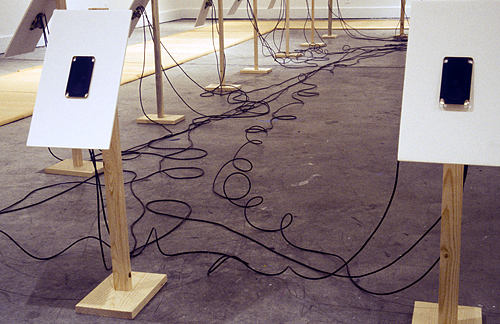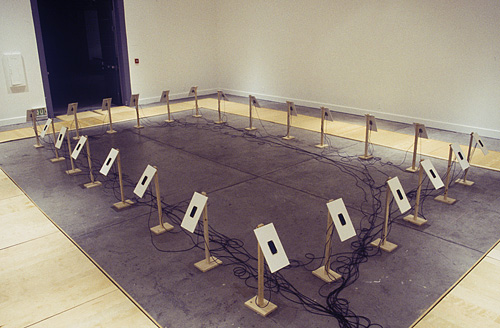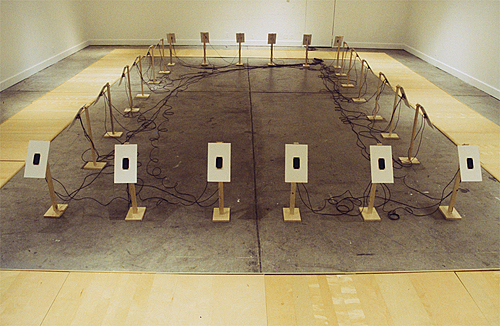Displacement
1.0 through 2.0
A series of interactive sound installations by Nina Waisman
Video demo:
Displacement
1 - 2.0
with Shashana Chittle, Alan Calpe, Annina Rust, and Melanie Badalato, and visitors to the California Center for the Arts.
As technology gains
access to previously unarticulated territory - the passages between poses,
the body's rhythms, the time and space between and around events - it
is worth considering what is at stake. Will our need to navigate this
evermore minutely mapped world lead to increased expressivity, increased
constraint, both, or something in between? Every "advance" in the ability
to capture information increases the turf over which battles between enclosure
and expression will be fought. Whose rhythms will guide our bodies' understandings
of these increasingly data-mined spaces?
Displacement 1.2 creates a subtly shifting displacement of visitors’ footsteps
in time and space. As a visitor walks along this path, her footsteps are
amplified and played back with increasing temporal delay. In counterpoint
to these steady temporal shifts, her sound shifts back and forth in space
through speakers running along the path – at times her footsteps play
through speakers ahead of her, at times through speakers behind. The mis-alignment
of the body’s natural “sound envelope’ evokes playful, meditative and
at times wary responses - some visitors felt stalked by their own technologically
displaced footsteps. Time constraints allowed me only to capture the more
playful reactions in my video documentation (links top of page); the video
also doesn't convey the spatialization of the sound. But the links above
give some idea of what the piece does.
The simple, looping path of displacement 1.2 might be understood as comfortingly similar to other paths we walk out in the world. The symmetrical square is like a village square, a meditative stroll around the block, a mall walk whose rules and manipulations we ease into. These bound walks can be relaxing. But they can also be stifling - scripted spaces one cannot escape. I see this path as a physical paralled to closed logical systems that we relax into or feel hamstrung by, reassured or tortured by. Closed systems keep disorder and creativity at bay; but they can also allow them to bloom as essential counter-rhythms.
This path, like paths and logic outside in the world, frequently became an occasion for social encounter, for dialogue. Breaking away from, or playing within the script, walkers created their own exchanges with the tools at hand.
I have created the modular interactive floor-tile-speaker system of “displacement” so that I might pursue a variety of sound and choreographic experiences working with the simple act of walking. Each iteration is site-specific, allowing for ongoing experiments with soundplay and choreography. Future iterations will have visitors' footsteps trigger non-walking sounds – concrete
sound that might suggest connections/impact on distant events.
While I continue work on these paths, I'm also generating a series
of videos that study what might happen if I set up the built paths to play back not the walkers' footsteps but others' footsteps - at times perfectly aligned with the the walkers' footsteps, and at times wandering off in different rhythms.

photo © 2006

photo © 2006
 photo © 2006
photo © 2006 
photo © 2006